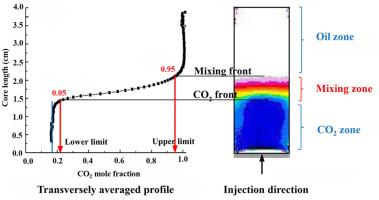Determining CO₂ front in CO₂-EOR using a well-testing method
IF 3.6
引用次数: 0
Abstract
CO2 flooding is a widely recognized method for enhanced oil recovery (EOR). This study aims to develop an accurate prediction method for determining the location and migration pathway of CO2 front, which plays an essential role in designing effective CO2 injection schemes and optimizing production strategies. Given the challenges of directly monitoring CO2 front movement in subsurface reservoirs, numerical well testing serves as an effective tool for indirectly inferring the location and migration characteristics of the CO2 front. This study established a numerical well-testing model based on a compositional framework to characterize interactions among multiple components during CO2 flooding. The methodology used in this model involves generating well-testing curves of CO2 flooding and then determining their flow stages based on CO2 distribution within reservoirs. Accordingly, a new well-testing analysis approach was proposed to determine the CO2 zone front and mixing zone front. This approach was applied to a pilot study of a practical oilfield, where it effectively predicted the positions of both fronts. The findings of this study reveal that the CO2 zone front and the mixing zone front correspond to the beginning of the first horizontal segment and the endpoint of the upward segment in the pressure derivative curve, respectively. This study introduces a cost-effective and time-efficient method for CO₂ front monitoring, addressing the challenges of high costs and prolonged durations typically associated with CO2-EOR operations.

利用试井方法确定CO₂-EOR中的CO₂前缘
二氧化碳驱油是一种被广泛认可的提高石油采收率的方法。本研究旨在建立一种准确的预测方法,确定CO2锋面的位置和运移路径,为设计有效的CO2注入方案和优化生产策略发挥重要作用。考虑到直接监测地下储层CO2锋面运动的挑战,数值试井是间接推断CO2锋面位置和运移特征的有效工具。本研究建立了一个基于组分框架的试井数值模型,以表征CO2驱过程中多个组分之间的相互作用。该模型使用的方法包括生成二氧化碳驱试井曲线,然后根据储层内的二氧化碳分布确定其流动级。据此,提出了一种新的试井分析方法来确定CO2带前缘和混合带前缘。该方法已应用于一个实际油田的试点研究,该方法有效地预测了两个锋面的位置。研究结果表明,CO2区锋面和混合区锋面分别对应压力导数曲线第一个水平段的起点和向上段的终点。该研究介绍了一种经济高效的CO₂前端监测方法,解决了CO - 2 eor作业的高成本和长时间的挑战。
本文章由计算机程序翻译,如有差异,请以英文原文为准。
求助全文
约1分钟内获得全文
求助全文

 求助内容:
求助内容: 应助结果提醒方式:
应助结果提醒方式:


